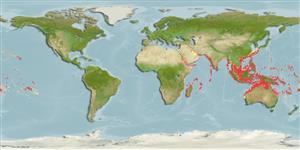Common names from other countries
>
Eupercaria/misc (Various families in series Eupercaria) >
Lethrinidae (Emperors or scavengers) > Monotaxinae
Etymology: Gymnocranius: Greek, gymnos = naked + Greek, kranion = skull (Ref. 45335).
More on author: Valenciennes.
Environment: milieu / climate zone / depth range / distribution range
Écologie
marin récifal; non migrateur; profondeur 20 - 170 m (Ref. 12260). Tropical; 35°N - 28°S, 32°E - 134°W
Indo-Pacific: East Africa to southeastern Oceania and from Australia northward to Japan. This species has been referred to as Gymnocranius robinsoni in recent literature.
Taille / Poids / Âge
Maturity: Lm ? range ? - ? cm
Max length : 80.0 cm TL mâle / non sexé; (Ref. 2295); common length : 64.0 cm SL mâle / non sexé; (Ref. 37816); poids max. publié: 5.5 kg (Ref. 40637)
Épines dorsales (Total): 10; Rayons mous dorsaux (Total): 10; Épines anales 3; Rayons mous anaux: 10.
Inhabits offshore reefs (Ref. 9710), trawling grounds of the continental shelves and offshore rocky bottoms (Ref. 30573). Juveniles inshore on muddy substrates (Ref. 48635). Solitary or in small groups (Ref. 90102). Feeds mostly on bottom invertebrates and small fishes (Ref. 30573). Potential commercial fish if sufficient stocks can be located (Ref. 9775). Marketed fresh (Ref. 9775); sometimes with a strong and unpleasant flavor (Ref. 11888).
Life cycle and mating behavior
Maturité | Reproduction | Frai | Œufs | Fécondité | Larves
Carpenter, K.E. and G.R. Allen, 1989. FAO Species Catalogue. Vol. 9. Emperor fishes and large-eye breams of the world (family Lethrinidae). An annotated and illustrated catalogue of lethrinid species known to date. FAO Fish. Synop. 125(9):118 p. Rome: FAO. (Ref. 2295)
Statut dans la liste rouge de l'IUCN (Ref. 130435)
CITES (Ref. 128078)
Not Evaluated
Menace pour l'homme
Harmless
Utilisations par l'homme
Pêcheries: intérêt commercial mineur
Plus d'informations
Noms communsSynonymesMétabolismePrédateursÉcotoxicologieReproductionMaturitéFraiFéconditéŒufsDéveloppement de l'œuf
RéférencesAquacultureProfil d'aquacultureSouchesGénétiqueElectrophoresesHéritabilitéPathologiesTraitementMass conversion
Outils
Articles particuliers
Télécharger en XML
Sources Internet
Estimates based on models
Preferred temperature (Ref.
115969): 21.6 - 28.3, mean 26.8 (based on 971 cells).
Phylogenetic diversity index (Ref.
82804): PD
50 = 0.5010 [Uniqueness, from 0.5 = low to 2.0 = high].
Bayesian length-weight: a=0.02042 (0.01172 - 0.03557), b=2.88 (2.73 - 3.03), in cm Total Length, based on LWR estimates for this species & (Sub)family-body (Ref.
93245).
Niveau trophique (Ref.
69278): 3.8 ±0.0 se; based on diet studies.
Résilience (Ref.
120179): Milieu, temps minimum de doublement de population : 1,4 à 4,4 années (K=0.23).
Fishing Vulnerability (Ref.
59153): Moderate vulnerability (42 of 100).
